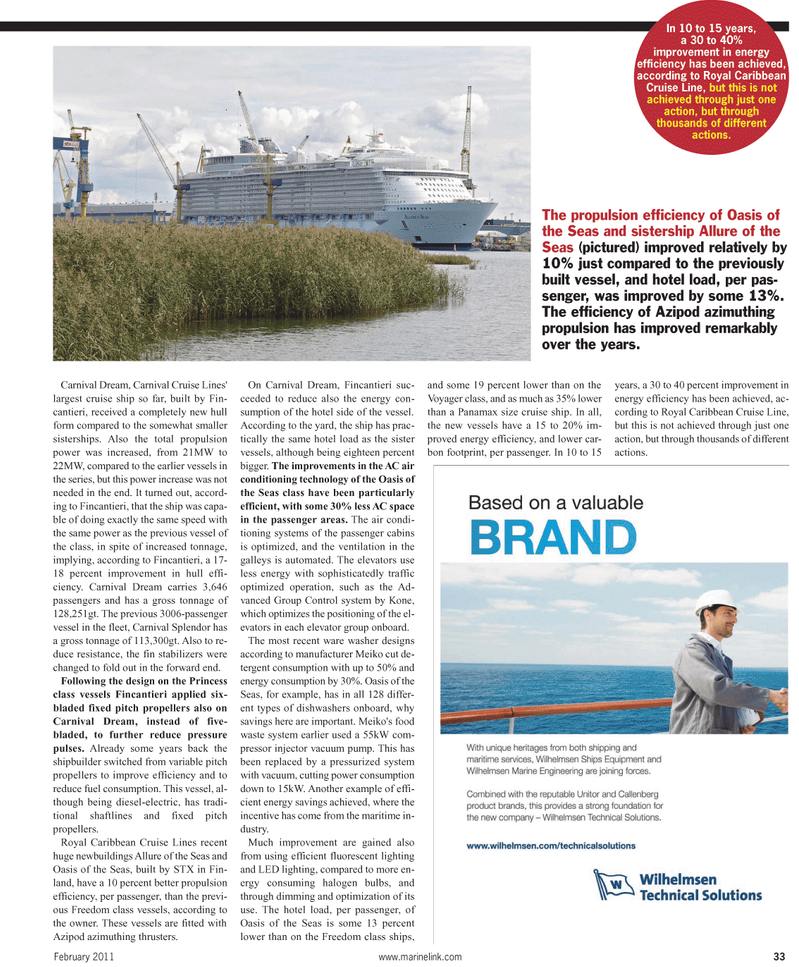
Page 33: of Maritime Reporter Magazine (February 2011)
Cruise & Passenger Vessel Annual
Read this page in Pdf, Flash or Html5 edition of February 2011 Maritime Reporter Magazine
February 2011 www.marinelink.com 33
Carnival Dream, Carnival Cruise Lines' largest cruise ship so far, built by Fin- cantieri, received a completely new hull form compared to the somewhat smaller sisterships. Also the total propulsion power was increased, from 21MW to 22MW, compared to the earlier vessels in the series, but this power increase was not needed in the end. It turned out, accord- ing to Fincantieri, that the ship was capa- ble of doing exactly the same speed with the same power as the previous vessel of the class, in spite of increased tonnage, implying, according to Fincantieri, a 17- 18 percent improvement in hull effi- ciency. Carnival Dream carries 3,646 passengers and has a gross tonnage of 128,251gt. The previous 3006-passenger vessel in the fleet, Carnival Splendor has a gross tonnage of 113,300gt. Also to re- duce resistance, the fin stabilizers were changed to fold out in the forward end.
Following the design on the Princess class vessels Fincantieri applied six- bladed fixed pitch propellers also on
Carnival Dream, instead of five- bladed, to further reduce pressure pulses. Already some years back the shipbuilder switched from variable pitch propellers to improve efficiency and to reduce fuel consumption. This vessel, al- though being diesel-electric, has tradi- tional shaftlines and fixed pitch propellers.
Royal Caribbean Cruise Lines recent huge newbuildings Allure of the Seas and
Oasis of the Seas, built by STX in Fin- land, have a 10 percent better propulsion efficiency, per passenger, than the previ- ous Freedom class vessels, according to the owner. These vessels are fitted with
Azipod azimuthing thrusters.
On Carnival Dream, Fincantieri suc- ceeded to reduce also the energy con- sumption of the hotel side of the vessel.
According to the yard, the ship has prac- tically the same hotel load as the sister vessels, although being eighteen percent bigger. The improvements in the AC air conditioning technology of the Oasis of the Seas class have been particularly efficient, with some 30% less AC space in the passenger areas. The air condi- tioning systems of the passenger cabins is optimized, and the ventilation in the galleys is automated. The elevators use less energy with sophisticatedly traffic optimized operation, such as the Ad- vanced Group Control system by Kone, which optimizes the positioning of the el- evators in each elevator group onboard.
The most recent ware washer designs according to manufacturer Meiko cut de- tergent consumption with up to 50% and energy consumption by 30%. Oasis of the
Seas, for example, has in all 128 differ- ent types of dishwashers onboard, why savings here are important. Meiko's food waste system earlier used a 55kW com- pressor injector vacuum pump. This has been replaced by a pressurized system with vacuum, cutting power consumption down to 15kW. Another example of effi- cient energy savings achieved, where the incentive has come from the maritime in- dustry.
Much improvement are gained also from using efficient fluorescent lighting and LED lighting, compared to more en- ergy consuming halogen bulbs, and through dimming and optimization of its use. The hotel load, per passenger, of
Oasis of the Seas is some 13 percent lower than on the Freedom class ships, and some 19 percent lower than on the
Voyager class, and as much as 35% lower than a Panamax size cruise ship. In all, the new vessels have a 15 to 20% im- proved energy efficiency, and lower car- bon footprint, per passenger. In 10 to 15 years, a 30 to 40 percent improvement in energy efficiency has been achieved, ac- cording to Royal Caribbean Cruise Line, but this is not achieved through just one action, but through thousands of different actions.
The propulsion efficiency of Oasis of the Seas and sistership Allure of the
Seas (pictured) improved relatively by 10% just compared to the previously built vessel, and hotel load, per pas- senger, was improved by some 13%.
The efficiency of Azipod azimuthing propulsion has improved remarkably over the years.
In 10 to 15 years, a 30 to 40% improvement in energy efficiency has been achieved, according to Royal Caribbean
Cruise Line, but this is not achieved through just one action, but through thousands of different actions.

 32
32

 34
34
